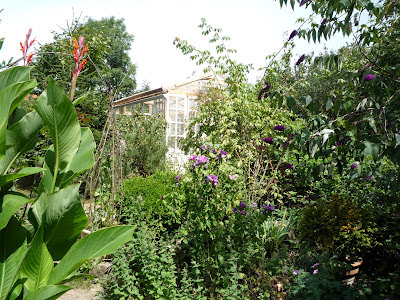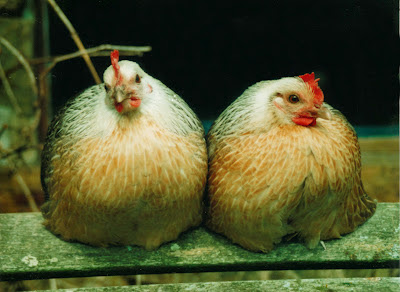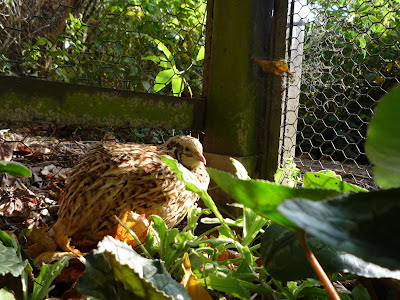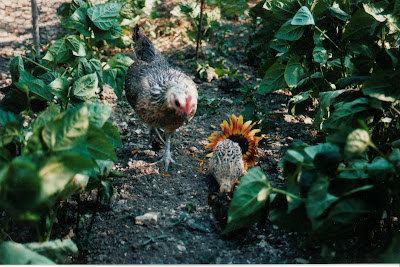Sitting is easy it's after hatching that the fun starts!
 My problem has always been in obtaining organic hatching eggs, so I have had to take what I could get. Most quail are hatched in incubators and to some extent a poor quality shell, due to inadequate diet and lack of Vitamin D from sunlight, isn't that much of an issue. However, an egg that is turned by a hen several times a day and may be trod on as she gets in and out of the nest is a problem. To counter this, I lift my hen on and off the nest, twice a day, once in the morning and once at night. I'm amazed, though I shouldn't be, how careful most hens are with quail eggs and it's usually when I have flustered the hen that I have had broken eggs. With Polly because of the experience with her Mother, who didn't take to the eggs immediately, I put a hen's egg into the nest as well and had an extra broody standing by to take over with it once the quail eggs hatched at 19 days. Seeing them together in the nest really illustrates the difficult task the hen has been given!
My problem has always been in obtaining organic hatching eggs, so I have had to take what I could get. Most quail are hatched in incubators and to some extent a poor quality shell, due to inadequate diet and lack of Vitamin D from sunlight, isn't that much of an issue. However, an egg that is turned by a hen several times a day and may be trod on as she gets in and out of the nest is a problem. To counter this, I lift my hen on and off the nest, twice a day, once in the morning and once at night. I'm amazed, though I shouldn't be, how careful most hens are with quail eggs and it's usually when I have flustered the hen that I have had broken eggs. With Polly because of the experience with her Mother, who didn't take to the eggs immediately, I put a hen's egg into the nest as well and had an extra broody standing by to take over with it once the quail eggs hatched at 19 days. Seeing them together in the nest really illustrates the difficult task the hen has been given! I took this shot later when the quail and Polly moved out into the warmest of the Greenhouses (recycled glass and pallet wood). From it you can see the relative size of the Ardenner and my adult quail (behind the compost bag). I had hoped to keep this female quail in the Greenhouse at the same time as Polly so she could integrate with the baby quail but Polly was having none of that and I had to separate them.
I took this shot later when the quail and Polly moved out into the warmest of the Greenhouses (recycled glass and pallet wood). From it you can see the relative size of the Ardenner and my adult quail (behind the compost bag). I had hoped to keep this female quail in the Greenhouse at the same time as Polly so she could integrate with the baby quail but Polly was having none of that and I had to separate them. Some thoughts about choosing a broody for quail
Problems with hatching eggs
Nutritional problems to watch out for in the first few days
 If you've been lucky enough to get hold of certified organic hatching eggs or eggs from a smallholding where the quail are kept outside and on a good natural diet then you won't come across nutritional problems. Eggs reflect totally the health of the bird who laid them. The main deficiencies I have come across are Vitamin B and Selenium, the latter seems most prevalent in domesticated commercial gamebirds in particular quail and peafowl. Vitamin B deficiency is something I've come across before in purchased fertile hens' eggs. A couple of days after hatching the chicks start to go down on one hock, begin to sit down frequently and finally lose the use of their legs and most often their toes curl up, hence the name 'curly toe paralysis'. This condition like many nutritional deficiencies in small growing chicks can be fatal but is easily and quickly remedied by balancing the diet. My thinking is that we are taking a weak chick and giving it a quite energetic and outdoor foraging life, if it was hatching in an incubator and kept in a cage on a chick ration it would probably survive a little longer before the symptoms show. In the life it will have with a Mother hen, these symptoms show quickly. I feed yeast flakes, actually chicks seem to like the flavour but I have gone so far as to sprinkle it onto an egg yolk, another good food for baby quail. Selenium deficiency again affects the nervous system and causes paralysis. The best form of Selenium is the brazil nut, however you only need the tiniest (3-4) fine gratings, as Selenium is actually toxic in large amounts and figuring what that means for a tiny quail is difficult. One way to know when your chicks may be suffering from either of these deficiencies is if you see your mother hen nudging the babies back onto their feet, it means she has noticed they are sitting too long. One of the ways in which hens naturally treat coccidiosis in chicks is to keep them on their feet and moving so that they eliminate the problem as quickly as possible.
If you've been lucky enough to get hold of certified organic hatching eggs or eggs from a smallholding where the quail are kept outside and on a good natural diet then you won't come across nutritional problems. Eggs reflect totally the health of the bird who laid them. The main deficiencies I have come across are Vitamin B and Selenium, the latter seems most prevalent in domesticated commercial gamebirds in particular quail and peafowl. Vitamin B deficiency is something I've come across before in purchased fertile hens' eggs. A couple of days after hatching the chicks start to go down on one hock, begin to sit down frequently and finally lose the use of their legs and most often their toes curl up, hence the name 'curly toe paralysis'. This condition like many nutritional deficiencies in small growing chicks can be fatal but is easily and quickly remedied by balancing the diet. My thinking is that we are taking a weak chick and giving it a quite energetic and outdoor foraging life, if it was hatching in an incubator and kept in a cage on a chick ration it would probably survive a little longer before the symptoms show. In the life it will have with a Mother hen, these symptoms show quickly. I feed yeast flakes, actually chicks seem to like the flavour but I have gone so far as to sprinkle it onto an egg yolk, another good food for baby quail. Selenium deficiency again affects the nervous system and causes paralysis. The best form of Selenium is the brazil nut, however you only need the tiniest (3-4) fine gratings, as Selenium is actually toxic in large amounts and figuring what that means for a tiny quail is difficult. One way to know when your chicks may be suffering from either of these deficiencies is if you see your mother hen nudging the babies back onto their feet, it means she has noticed they are sitting too long. One of the ways in which hens naturally treat coccidiosis in chicks is to keep them on their feet and moving so that they eliminate the problem as quickly as possible.A few words about feathers
How to avoid those busy hen's feet.
 I like to get baby birds outdoors as quickly as possibly, as soon as it hits 16 degrees C. I always tend to start them in a small run, as even at that temperature some baby chicks can still get cold. Sebright chicks in particular feel the cold keenly and they need the mother to be nearby if that happens. A good hen will always sit if a chick starts to try to get underneath her, she instinctively knows it is cold and/or tired. With quail in the past I have bought the outdoors in with a complex set of runs fitted with areas of grass and soil. However since Andy started making Greenhouses, it has given me an ideal place to put the quail in the first few days. The only thing to be aware of is dust baths because that will be the first thing a Mother hen wants to take. If you look at the film at the end of my previous post on quail you will see how I got round this by creating a run within the greenhouse so that the quail and Polly could still see each other whilst she was dust bathing.
I like to get baby birds outdoors as quickly as possibly, as soon as it hits 16 degrees C. I always tend to start them in a small run, as even at that temperature some baby chicks can still get cold. Sebright chicks in particular feel the cold keenly and they need the mother to be nearby if that happens. A good hen will always sit if a chick starts to try to get underneath her, she instinctively knows it is cold and/or tired. With quail in the past I have bought the outdoors in with a complex set of runs fitted with areas of grass and soil. However since Andy started making Greenhouses, it has given me an ideal place to put the quail in the first few days. The only thing to be aware of is dust baths because that will be the first thing a Mother hen wants to take. If you look at the film at the end of my previous post on quail you will see how I got round this by creating a run within the greenhouse so that the quail and Polly could still see each other whilst she was dust bathing.  In those first few days in the Greenhouse I still supervised Polly and the quail and they needed to be brought back indoors into their nest as soon as they showed any signs of getting cold. You'll know when this is as baby quail are not shy and retiring when it comes to wanting something, they make an insistent whining noise when they are cold!
In those first few days in the Greenhouse I still supervised Polly and the quail and they needed to be brought back indoors into their nest as soon as they showed any signs of getting cold. You'll know when this is as baby quail are not shy and retiring when it comes to wanting something, they make an insistent whining noise when they are cold!Thanks for dropping by and do feel free to share experiences or ask for further information in the comment section. If you have enjoyed this piece and found it useful think about sharing it with your family and friends, on social media and also maybe about joining this blog and/or subscribing to my Youtube, Odysee or BitChute Channel or even supporting us on Patreon or
Until next time, all the very best from sunny Normandie!
SueRELATED ARTICLES
 Why and how? Getting started.
Why and how? Getting started.
 How your hen can bring out the best in baby quail.
How your hen can bring out the best in baby quail.
 A comprehensive guide into the history & use of quail eggs in medicine Part 1
A comprehensive guide into the history & use of quail eggs in medicine Part 1
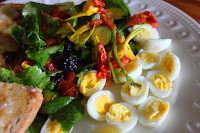 A comprehensive guide into the history & use of quail eggs in medicine Part 2
A comprehensive guide into the history & use of quail eggs in medicine Part 2
RETURN TO CONTENTS PAGE
©Sue Cross 2012






